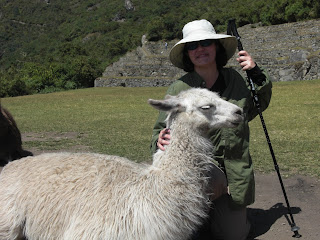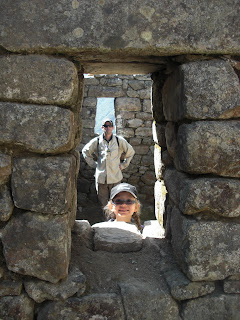After trying every conceivable rationalization for spending $1000 to fly ourselves to Trujillo we were forced to concede defeat and board the stupid 2 day bus. Though we begrudge the bus it should be said that the bus in Peru is far superiour to anything Greyhound has to offer. Actually we lucked out in a way because the first leg of our bus ride arrived a few hours early so we were able to get an earlier bus to Trujillo, which, though it arrived late allowed us to avoid 2 consecutive nights sleeping on the bus- sort of.
We spent our first day in Trujillo wandering the Plaza de Armas and Plaza Mayor. This city boasts fabulous carved balconies like Cusco, but has the additional fun element of fantasical wrought iron decorations on the lower windows. Another unique aspect of Trujillo's street scene are the vivid colors of the beautiful colonial architecture. We also toured the small archaeological museum in town which presents an overview of the various cultures that have inhabited Peru since about 10,000 years ago.
The next day we got up very early in order to be ready to head out to Lambayeque. This was not necessary as we ended up sitting around until after 9:30. Clara, after describing how to get there solo must have decided that we weren't up to it because in the end she came with us. We are telling ourselves that it is because we told her we wanted to see as much as possible and not that we looked like pansies. Anyway, after a 3 hour bus ride to Chiclayo we took a taxi to Lambayeque and went to lunch. We had a couple of Peruvian potato dishes which were amazing. Brad thinks they would have been better hot but no one is asking him. Then we drove out into the hinterlands to the village of Tucume. There, down a very special "road" are the ruins of a large city/ ceremonial center. El Nino rains have damaged the exteriors of the pyramids but enough is left give you an idea of how advanced these cultures were.
In the north each site has a history with several cultures. Each group of people basically built their stuff on top of the previous groups'. The earliest empire of the north coast was the Moche starting about 2000 years ago. After them you have the Lambayeque, then Chimu, then Inca. There are some that I'm leaving out but in the end it all went to the Spanish who looted every grave they could find and melted everything into ingots and sent it to Spain. At Tucume the ground is literally covered with potsherds. I asked Clara who was able at a glance to identify them as Moche and Chimu. Each of the groups had amazing ceramic and textile tradtions and sprawling trade networks evidenced by the discovery up and down the Andes of articles from all of these peoples.
After Tucume we raced back to town. We were to learn that when Clara said "vamos" she meant it. She would head out and not look back. (Clara owns the hostal we stayed in and was the first officail guide in the area. She worked the digs where all the objects in the museums were found. Anyone who has done any archaeology in Peru in the last 40 years, she knows them. She met Thor Heyerdahl when he was in Peru working on the Kon-Tiki. I will add that she is at most 5 inches taller that Zada.) So, we were off to the museum that showcases the fabulouness of the the Lord of Sipan. He was a Moche big wig about 1500 years ago at the north end of their empire which is around Lambayeque. There's a link on Zada's blog to a photo gallery of his trappings. The best thing we learned at the museum was all of the traditional remedies these people used. Our favorite, guinea pig massage. Seriously. Also, for asthma and arthitis they would cover you with the puppies of the hairless Peruvian dogs. These treaments would have been carried out by a shaman with great seriousness and ceremony. So take a moment and try to picture one of these priests, decked out in his gold and silver, with a magnificent headdress and robes, rubbing a live guinea pig on a man's sore leg.
The place was awesome and sadly, because of our "Peru time" start, we had to race through the last bit. We did see what was left of El Senor, which isn't much. Clara vamosed us back to the bus station and we got back quite late. The next morning we accounted for the difference in Peruvian ideas about punctuality and got up a bit later. Clara took us and a few other hostal guests on a tour of the archaeological sites around Trujillo. Our first stop was Chan Chan, the capital of the Chimu empire, built around 900AD. Most of the original site has been destroyed by a thousand years of exposure to the elements but you can still tell how large the place was and what skilled builders they must have been. Here, unlike Tucume, a few of the walls retain hints of their original painted color. As amazing as it looks today it must have been unreal when it was all painted blue, yellow and red. The Tschudi complex (a mere 1/25 of the enormous site) has been well excavated and we admired the beautifully carved sea life reliefs. The various decorative maritime elements are rendered naturalistically and abstractly in different sites. The interiors walls are an elaborate lattice-work representing nets as well as providing light/air flow and privacy. These people were phenomenal engineers and their adobe brickwork is all trapedzoidal with rubble fill and stuccoed over to fresco. This shape and the small stone fill provides tremendous stability in this quake-prone region. Clara also pointed out that all modern construction had been essentially destroyed several times in past disasters, but this site is still wonderfully intact.
We marvelled at the wonderful artistry and Zada pestered a few more hairless dogs then jumped back into the minibus to the next ancient wonder. This was the Huaco Arco Iris. WE haven't raved enough about the incredible irrigation/ aqueduct / hey these people built huge civilizations in the desert aspect of all these cultures, but its is really late/early and we've been on a bus/ van/ taxi/ plane/ shuttle since Tuesday and although our appreciation and enthusiasm for the extraordinary accomplishments of the Pre-conquest civilaztions has not in any way waned, it is getting harder and harder to string these adjectives together in any kind of meaningful way. Don't worry though, once we see you, you'll hear far more about all of this than you could ever have imagined.
Anyhow, Arco Iris - the rainbow. This sacred site had three levels and the reliefs are amazing - They feature - I'll just include a photo ... it is pretty obvious what with the serpent rainbow and such.
The last site of the day was definitely one of the best things we saw in Peru. It was the Huaca de la Luna, the Temple of the Moon. This is a Moche construction originally so it's over 1500 years old. It's next to the Temple of the Sun which hasn't been excavated and so looks like a muddy, tiered hill. Clara led us around to the the reliefs and frescos, many of which are so well preserved that the colors are intact. The highlight was north side of the pyramid which has seven stories of painted carvings is stunning condition. The walls of each story were over 100 yards long, each level having a different repeated image. And though each image was the same, the faces each had a different expression, some smiling, some angry, and so on. Our favorite was the image of the the creature with the body of a man, head of a jaguar, and the tail of an iguana, each holding a severed human head. Also, check Zada's blog for the wall that was a spectacular patchwork of images, possibly their entire cosmographia.
It's now 4:51 here at Washington Dulles Airport baggage claim and we are running out of ATT wifi time so we'll be going now. When we get home later today we will put in some pictures so you can see what we have been gibbering about. Thanks fo visiting and we'll talk to you soon.

















.JPG)
